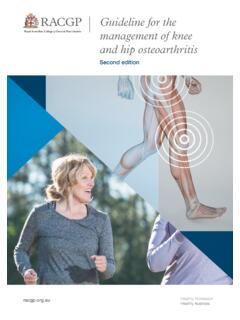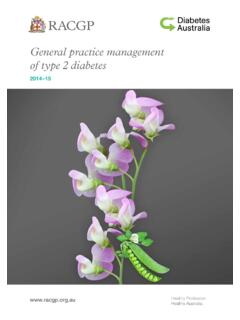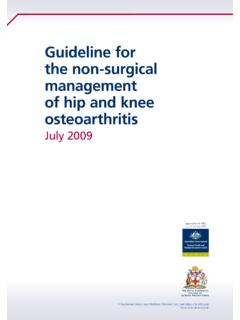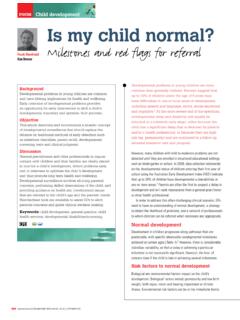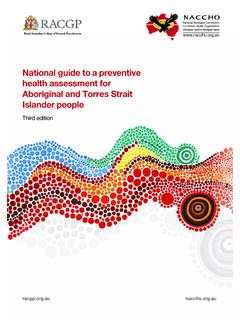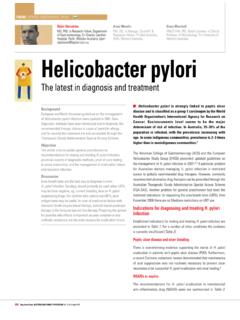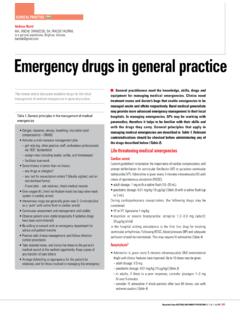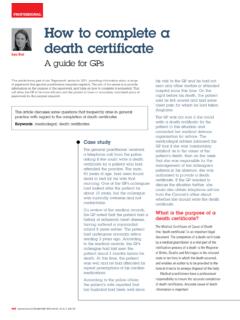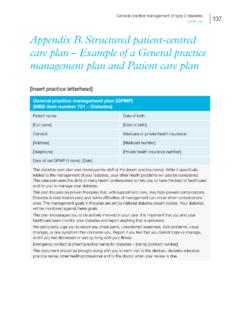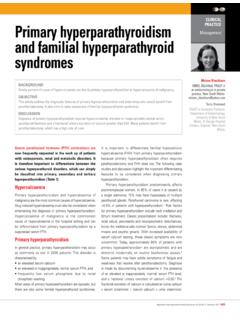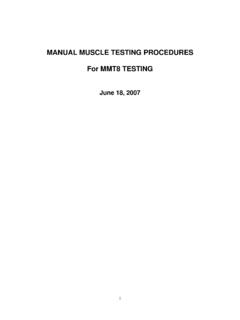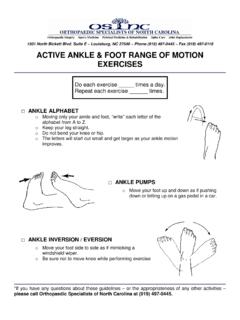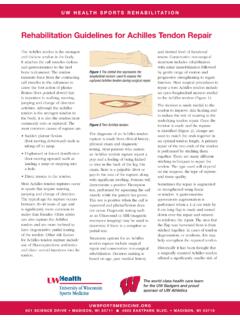Transcription of Sports ankle injuries Assessment and management
1 FOCUSS ports injuries18 Reprinted from AustRAli An FAmily PhysiciAn Vol. 39, no. 1/2, JAnuARy/FebRuARy 2010 Background Sports ankle injuries present commonly in the general practice setting. The majority of these injuries are inversion and plantar flexion injuries that result in damage to the lateral ligament aim of this article is to review the Assessment and management of Sports ankle injuries in the general practice of an ankle injury begins with a detailed history to determine the severity, mechanism and velocity of the injury, what happened immediately after and whether there is a past history of inadequately rehabilitated ankle injury.
2 Examination involves Assessment of weight bearing, inspection, palpation, movement, and application of special examination tests. Plain X-rays may be helpful to exclude a fracture. If the diagnosis is uncertain, consider second line investigations including bone scan, computerised tomography or magnetic resonance imaging, and referral to a Sports physician. Manage all lateral ligament complex ankle sprains with ice, compression, elevation where possible and analgesia. Severe ligament sprains or rupture benefit from a brief period of immobilisation.
3 After initial management , the athlete should complete a 6 week guided rehabilitation program. Athletes with moderate to severe lateral ankle ligament sprains should wear a semirigid or rigid ankle orthosis for at least 6 months following : ankle ; athletic injuries ; soft tissue injuries Sports ankle injuries Assessment and managementThe majority of ankle injuries are inversion and plantar flexion injuries that result in damage to the lateral ligament complex (Figure 1). The main ligaments of concern are the anterior talofibular ligament (ATFL), the calcaneofibular ligament (CFL), and the anterior tibiofibular ligament (also called the anterior inferior tibiofibular ligament or AITFL).
4 The AITFL is the anterior component of the syndesmosis complex (Figure 2). A thorough history including past history and examination will determine the need for investigations and guide appropriate management . HistoryInjury detailssevere ligament sprains or ruptures occur with high velocity injuries , such as landing on a player s foot while jumping or running. simply rolling the ankle on an uneven surface while walking is unlikely to cause a ligament rupture or fracture in the setting of normal bone density and ligament integrity, ie.
5 There is no history of prior ligament damage. Dorsiflexion and eversion injuries can cause damage to the syndesmosis (Figure 2). A syndesmosis injury takes significantly longer to recover than a lateral ligament injury and, if unstable, warrants immediate surgical studyLucia is a female, 16 years of age, who plays netball with the state under 17s netball team. She presents with an ankle injury sustained at training the previous night. She is on crutches and is nonweight bearing. Examination raises the possibility of a fracture, but X-ray is negative.
6 You diagnose a severe lateral ligament sprain and manage Lucia with ice, a compression bandage and a backslab initially. She then progresses through a 6 week rehabilitation program and you recommend she wear an ankle brace for at least 6 SlimmonPeter BruknerReprinted from AustRAli An FAmily PhysiciAn Vol. 39, no. 1/2, JAnuARy/FebRuARy 2010 19 Postinjury detailsAfter a ruptured ligament or fracture, athletes are unlikely to be able to continue training or playing sport, and may be unable to weight bear (particularly with a fracture).
7 Swelling within minutes or hours is the result of the bleeding that occurs with a ligament rupture or fracture/dislocation; swelling from synovitis takes longer to develop. Reports of a cracking noise or the feeling that the ankle bent double cannot differentiate between a fracture, ligament rupture or ligamentous historythe past history provides the practitioner with an understanding of the state of the ankle before the current injury. inadequate rehabilitation and a subsequently chronically unstable ankle would be expected to take significantly longer to completely rehabilitate.
8 It is important to clarify the extent of any previous injury and any investigations or treatment. if a rehabilitation program was instituted, the clinician should seek details of the type and duration of the program. Appropriate rehabilitation programs focus on range of motion , proprioception, strength and Sports specific exercises, and are usually a minimum of 6 weeks duration. Asking about previous or current use of a semirigid brace or tape may offer insight into the adequacy of past rehabilitation efforts as this is an important component of rehabilitation.
9 Examination examination of the injured ankle includes: Weight bearing if the patient cannot weight bear on the affected leg for more than four steps unaided, ankle X-rays should be ordered (Figure 3)2 Inspection discoloration haematoma and significant swelling are suggestive of ligament rupture or fracture Palpation pain on palpation of the posterior aspect of the medial and lateral malleolus (both sites are void of ligamentous attachments), the base of the fifth metatarsal and the proximal fibula are suggestive of fracture (Figure 3).
10 2 lack of tenderness on palpation of the AtFl excludes AtFl rupture Range of movement this may not assist diagnosis acutely and is likely to be limited by acute swelling and examination tests these may not assist diagnosis acutely as a result of swelling and pain. In this situation the examination should be repeated 3 5 days later when pain and swelling have drawer test this is performed with the knee at 90 degress of flexion and the muscles relaxed. increased laxity compared to the contralateral ankle reflects injury to the AtFl and possibly the cFl.
